Barra Risk Model
Barra Risk Model
Handbook
�
The user of the Information assumes the entire risk of any use it may make or permit to be
In particular, historical data and analysis should not be taken as an indication or guarantee
Historical data and analysis should not be taken as an indication or guarantee of any
•
This document and all of the information contained in it, including without limitation all text,
data, graphs, charts (collectively, the “Information”) is the property of MSCl Inc. (“MSCI”), Barra, Inc.
(“Barra”), or their affiliates (including without limitation Financial Engineering Associates, Inc.) (alone
or with one or more of them, “MSCI Barra”), or their direct or indirect suppliers or any third party
involved in the making or compiling of the Information (collectively, the “MSCI Barra Parties”), as
applicable, and is provided for informational purposes only. The Information may not be reproduced
or redisseminated in whole or in part without prior written permission from MSCI or Barra, as
applicable.
•
The Information may not be used to verify or correct other data, to create indices, risk
models or analytics, or in connection with issuing, offering, sponsoring, managing or marketing any
securities, portfolios, financial products or other investment vehicles based on, linked to, tracking or
otherwise derived from any MSCI or Barra product or data.
•
future performance, analysis, forecast or prediction.
•
None of the Information constitutes an offer to sell (or a solicitation of an offer to
buy), or a promotion or recommendation of, any security, financial product or other
investment vehicle or any trading strategy, and none of the MSCI Barra Parties endorses,
approves or otherwise expresses any opinion regarding any issuer, securities, financial
products or instruments or trading strategies. None of the Information, MSCI Barra indices,
models or other products or services is intended to constitute investment advice or a
recommendation to make (or refrain from making) any kind of investment decision and may
not be relied on as such.
•
made of the Information.
•
of any future performance, analysis or prediction.
•
NONE OF THE MSCI BARRA PARTIES MAKES ANY EXPRESS OR IMPLIED
WARRANTIES OR REPRESENTATIONS WITH RESPECT TO THE INFORMATION (OR THE
RESULTS TO BE OBTAINED BY THE USE THEREOF), AND TO THE MAXIMUM EXTENT
PERMITTED BY LAW, MSCI AND BARRA, EACH ON THEIR BEHALF AND ON THE BEHALF OF
EACH MSCI BARRA PARTY, HEREBY EXPRESSLY DISCLAIMS ALL IMPLIED WARRANTIES
(INCLUDING, WITHOUT LIMITATION, ANY
IMPLIED WARRANTIES OF ORIGINALITY,
ACCURACY, TIMELINESS, NON-INFRINGEMENT, COMPLETENESS, MERCHANTABILITY AND
FITNESS FOR A PARTICULAR PURPOSE) WITH RESPECT TO ANY OF THE INFORMATION.
•
Without limiting any of the foregoing and to the maximum extent permitted by law, in no
event shall any of the MSCI Barra Parties have any liability regarding any of the Information for any
direct, indirect, special, punitive, consequential (including lost profits) or any other damages even if
notified of the possibility of such damages. The foregoing shall not exclude or limit any liability that
may not by applicable law be excluded or limited.
•
Any use of or access to products, services or information of MSCI or Barra or their
subsidiaries requires a license from MSCI or Barra, or their subsidiaries, as applicable. MSCI, Barra,
MSCI Barra, EAFE, Aegis, Cosmos, BarraOne, and all other MSCI and Barra product names are the
trademarks, registered trademarks, or service marks of MSCI, Barra or their affiliates, in the United
States and other jurisdictions. The Global Industry Classification Standard (GICS) was developed by
and is the exclusive property of MSCI and Standard & Poor’s. “Global Industry Classification
Standard (GICS)” is a service mark of MSCI and Standard & Poor’s.
•
York without regard to its conflict or choice of law principles.
© 2007 MSCI Barra. All rights reserved.
The governing law applicable to these provisions is the substantive law of the State of New
RV 10-2007
�
Contents
About Barra . . . . . . . . . . . . . . . . . . . . . . . . . . . . . . . . . . . . . . . . . v
A Pioneer in Risk Management . . . . . . . . . . . . . . . . . . . . . . . . . . . v
Contacting Barra . . . . . . . . . . . . . . . . . . . . . . . . . . . . . . . . . . . . .vi
Other Barra Resources . . . . . . . . . . . . . . . . . . . . . . . . . . . . . . . . .vi
Introduction . . . . . . . . . . . . . . . . . . . . . . . . . . . . . . . . . . . . . . . . vii
1. Forecasting Risk with Multiple-Factor Models . . . . . . . . . . . .1
What Are Multiple-Factor Models? . . . . . . . . . . . . . . . . . . . . . . . . 1
How Do Multiple-Factor Models Work? . . . . . . . . . . . . . . . . . . . . 2
Advantages of Multiple-Factor Models. . . . . . . . . . . . . . . . . . . . . . 2
An Illustration of Multiple-Factor Models . . . . . . . . . . . . . . . . . . . 3
Model Mathematics . . . . . . . . . . . . . . . . . . . . . . . . . . . . . . . . . . . 5
Single-Factor Model . . . . . . . . . . . . . . . . . . . . . . . . . . . . . . . . 6
Multiple-Factor Model . . . . . . . . . . . . . . . . . . . . . . . . . . . . . . 6
Multiple-Asset Portfolio . . . . . . . . . . . . . . . . . . . . . . . . . . . . . 8
Risk Prediction with MFMs . . . . . . . . . . . . . . . . . . . . . . . . . . . . . 8
The Covariance Matrix . . . . . . . . . . . . . . . . . . . . . . . . . . . . . 10
Deriving the Variance-Covariance Matrix of Asset Returns. . . 10
Final Risk Calculation . . . . . . . . . . . . . . . . . . . . . . . . . . . . . 11
Summary . . . . . . . . . . . . . . . . . . . . . . . . . . . . . . . . . . . . . . . . . . 12
2. Forecasting Equity Risk . . . . . . . . . . . . . . . . . . . . . . . . . . . .15
A Historical Perspective . . . . . . . . . . . . . . . . . . . . . . . . . . . . . . . 15
Barra’s Equity Multiple-Factor Model . . . . . . . . . . . . . . . . . . . . . 19
Common Factors . . . . . . . . . . . . . . . . . . . . . . . . . . . . . . . . . . . . 20
Risk Indices . . . . . . . . . . . . . . . . . . . . . . . . . . . . . . . . . . . . . 20
Industries . . . . . . . . . . . . . . . . . . . . . . . . . . . . . . . . . . . . . . . 20
Specific Risk . . . . . . . . . . . . . . . . . . . . . . . . . . . . . . . . . . . . . . . . 20
Contents
i
�
3. Barra Equity Risk Modeling . . . . . . . . . . . . . . . . . . . . . . . . 21
Model Estimation Overview . . . . . . . . . . . . . . . . . . . . . . . . . . . . 21
Data Acquisition . . . . . . . . . . . . . . . . . . . . . . . . . . . . . . . . . . . . 24
Descriptor Selection and Testing . . . . . . . . . . . . . . . . . . . . . . . . . 24
Descriptor Standardization . . . . . . . . . . . . . . . . . . . . . . . . . . . . . 25
Risk Index Formulation . . . . . . . . . . . . . . . . . . . . . . . . . . . . . . . 25
Industry Allocation. . . . . . . . . . . . . . . . . . . . . . . . . . . . . . . . . . . 26
Factor Return Estimation . . . . . . . . . . . . . . . . . . . . . . . . . . . . . . 27
Covariance Matrix Calculation . . . . . . . . . . . . . . . . . . . . . . . . . . 27
Exponential Weighting . . . . . . . . . . . . . . . . . . . . . . . . . . . . . 28
Covariance Matrix Scaling: Computing Market Volatility . . . 29
Specific Risk Modeling . . . . . . . . . . . . . . . . . . . . . . . . . . . . . . . . 33
Methodology . . . . . . . . . . . . . . . . . . . . . . . . . . . . . . . . . . . . 33
Updating the Model . . . . . . . . . . . . . . . . . . . . . . . . . . . . . . . . . . 35
4. Forecasting Fixed-Income Risk . . . . . . . . . . . . . . . . . . . . . . 39
A Historical Perspective . . . . . . . . . . . . . . . . . . . . . . . . . . . . . . . 39
Barra’s Multiple-Factor Model . . . . . . . . . . . . . . . . . . . . . . . . . . . 40
Common Factors . . . . . . . . . . . . . . . . . . . . . . . . . . . . . . . . . . . . 41
Interest Rate Risk . . . . . . . . . . . . . . . . . . . . . . . . . . . . . . . . . 43
Spread Risk . . . . . . . . . . . . . . . . . . . . . . . . . . . . . . . . . . . . . 46
Specific Risk . . . . . . . . . . . . . . . . . . . . . . . . . . . . . . . . . . . . . . . 49
Summary . . . . . . . . . . . . . . . . . . . . . . . . . . . . . . . . . . . . . . . . . . 49
5.
Interest Rate Risk Modeling . . . . . . . . . . . . . . . . . . . . . . . . 51
Estimation Process Overview . . . . . . . . . . . . . . . . . . . . . . . . . . . 51
Term Structure Specification . . . . . . . . . . . . . . . . . . . . . . . . . . . . 55
Interpolation . . . . . . . . . . . . . . . . . . . . . . . . . . . . . . . . . . . . 55
Estimation Algorithm Implementation . . . . . . . . . . . . . . . . . 58
Factor Shape Determination . . . . . . . . . . . . . . . . . . . . . . . . . . . . 63
Factor Exposure Calculation . . . . . . . . . . . . . . . . . . . . . . . . . . . . 64
Factor Return Estimation . . . . . . . . . . . . . . . . . . . . . . . . . . . . . . 65
Term Structure Covariance Matrix Construction . . . . . . . . . . . . . 66
Covariance Matrix Correlation . . . . . . . . . . . . . . . . . . . . . . . . . . 66
Updating the Model . . . . . . . . . . . . . . . . . . . . . . . . . . . . . . . . . . 67
ii
Barra Risk Model
Handbook
�
6. Spread Risk Modeling . . . . . . . . . . . . . . . . . . . . . . . . . . . . .69
Swap Spread Risk Model . . . . . . . . . . . . . . . . . . . . . . . . . . . . . . . 70
Data Acquisition and Factor Return Estimation. . . . . . . . . . . 70
Factor Exposure Calculation . . . . . . . . . . . . . . . . . . . . . . . . . 70
Detailed Credit Spread Risk Model . . . . . . . . . . . . . . . . . . . . . . . 71
Currency Dependence . . . . . . . . . . . . . . . . . . . . . . . . . . . . . 72
Model Structure . . . . . . . . . . . . . . . . . . . . . . . . . . . . . . . . . . 74
Data Acquisition . . . . . . . . . . . . . . . . . . . . . . . . . . . . . . . . . 77
Factor Return Estimation . . . . . . . . . . . . . . . . . . . . . . . . . . . 77
Covariance Matrix Estimation. . . . . . . . . . . . . . . . . . . . . . . . 77
Factor Exposure Calculation . . . . . . . . . . . . . . . . . . . . . . . . . 78
Emerging-Market Risk Modeling . . . . . . . . . . . . . . . . . . . . . . . . 78
Model Structure . . . . . . . . . . . . . . . . . . . . . . . . . . . . . . . . . . 79
Data Acquisition and Factor Return Estimation. . . . . . . . . . . 80
Covariance Matrix Estimation. . . . . . . . . . . . . . . . . . . . . . . . 80
Factor Exposure Calculation . . . . . . . . . . . . . . . . . . . . . . . . . 81
Updating the Model . . . . . . . . . . . . . . . . . . . . . . . . . . . . . . . . . . 81
7. Specific Risk Modeling. . . . . . . . . . . . . . . . . . . . . . . . . . . . .83
Heuristic Models . . . . . . . . . . . . . . . . . . . . . . . . . . . . . . . . . . . . 83
Data Acquisition . . . . . . . . . . . . . . . . . . . . . . . . . . . . . . . . . 83
Sovereign, U.S. Agency, and MBS Specific Risk Estimation . . 84
Corporate Bond Specific Risk Estimation . . . . . . . . . . . . . . . 85
Transition-Matrix-Based Model. . . . . . . . . . . . . . . . . . . . . . . . . . 86
Data Acquisition . . . . . . . . . . . . . . . . . . . . . . . . . . . . . . . . . 87
Transition Matrix Generation . . . . . . . . . . . . . . . . . . . . . . . . 87
Rating Spread Level Calculation . . . . . . . . . . . . . . . . . . . . . . 88
Credit Migration Forecasting . . . . . . . . . . . . . . . . . . . . . . . . 91
Updating the Model . . . . . . . . . . . . . . . . . . . . . . . . . . . . . . . . . . 94
8. Currency Risk Modeling . . . . . . . . . . . . . . . . . . . . . . . . . . . .97
Model Structure . . . . . . . . . . . . . . . . . . . . . . . . . . . . . . . . . . . . . 97
Data Acquisition and Return Calculation . . . . . . . . . . . . . . . . . . 98
Estimation of the Covariance Matrix . . . . . . . . . . . . . . . . . . . . . . 98
Currency Correlation Model . . . . . . . . . . . . . . . . . . . . . . . . . 99
Currency Volatility Model. . . . . . . . . . . . . . . . . . . . . . . . . . 100
Contents
iii
�
Volatility Across Markets . . . . . . . . . . . . . . . . . . . . . . . . . . 102
Time-Scaling Currency Risk Forecasts . . . . . . . . . . . . . . . . . . . . 105
Updating the Model . . . . . . . . . . . . . . . . . . . . . . . . . . . . . . . . . 106
9.
Integrated Risk Modeling . . . . . . . . . . . . . . . . . . . . . . . . . 109
Model Integration Overview . . . . . . . . . . . . . . . . . . . . . . . . . . 109
Building Global Asset Class Models . . . . . . . . . . . . . . . . . . . . . 110
The Structure of Local Models . . . . . . . . . . . . . . . . . . . . . . 111
Aggregating Local Models . . . . . . . . . . . . . . . . . . . . . . . . . . 111
Implementing Global Factor Models . . . . . . . . . . . . . . . . . . 113
Consistency Between Local Models and Global Model . . . . 114
Global Equities. . . . . . . . . . . . . . . . . . . . . . . . . . . . . . . . . . . . . 114
Global Equity Factors . . . . . . . . . . . . . . . . . . . . . . . . . . . . . 115
Exposures of Local Equity Factors to Global Equity Factors . 115
Estimating Returns to Global Equity Factors . . . . . . . . . . . . 115
Computing Covariances of Global Equity Factors . . . . . . . . 117
Scaling to Local Markets. . . . . . . . . . . . . . . . . . . . . . . . . . . 117
Global Bonds . . . . . . . . . . . . . . . . . . . . . . . . . . . . . . . . . . . . . . 118
Global Bond Factors . . . . . . . . . . . . . . . . . . . . . . . . . . . . . . 119
Exposures of Local Bond Factors to Global Bond Factors. . . 122
Computing Covariances Of Global Bond Factors . . . . . . . . 122
The Currency Model . . . . . . . . . . . . . . . . . . . . . . . . . . . . . . . . 123
Putting It All Together—A Multi-Asset Class Risk Model . . . . . 125
Summary . . . . . . . . . . . . . . . . . . . . . . . . . . . . . . . . . . . . . . . . . 128
Glossary . . . . . . . . . . . . . . . . . . . . . . . . . . . . . . . . . . . . . . . . . . . . 131
Contributors . . . . . . . . . . . . . . . . . . . . . . . . . . . . . . . . . . . . . . . . . 181
Index . . . . . . . . . . . . . . . . . . . . . . . . . . . . . . . . . . . . . . . . . . . . . . . 183
iv
Barra Risk Model
Handbook
�
About Barra
In recent years the investment management industry has adjusted
to continuing changes—theoretical advances, technological devel-
opments, and volatility. To address these, investment managers
and financial institutions require the most advanced and powerful
analytical tools available.
A Pioneer in Risk Management
As the leading provider of global investment decision support
tools and innovative risk management technology, Barra has
responded to these industry changes by providing quantitative
products and services that are both flexible and efficient.
Barra products are a combination of advanced technology and
superior analytics, research, models, and data that provide clients
around the world with comprehensive risk management solutions.
Barra uses the best data available to develop econometric financial
models. In turn, these models are the basis of software products
designed to enhance portfolio performance through returns fore-
casting, risk analysis, portfolio construction, transaction cost anal-
ysis, and historical performance attribution.
With more than 80 researchers in offices around the world and
products that cover most of the world’s traded securities, Barra
maintains one of the strongest risk management research practices
in the world today.
About Barra
v
�
Contacting Barra
Client Services is available 24 hours a day, Monday through Fri-
day. You can reach the Client Services as follows:
Web:
http://www.barra.com/support/service_request/
new_request.asp
Phone: North America:
888.588.4567
Europe:
Asia:
+44 (0)20.7618.2222
+813 5424 5470 (Japanese)
For local access numbers, visit the Client Support web site,
http://support.barra.com.
Client Services is your first point of contact concerning your
Barra product or service. Support desk analysts are available to
assist you with general, technical, data, product usage, and model
questions.
Other Barra Resources
You can visit the Library at http://support.barra.com for more
information on the topics discussed in this handbook.
In addition to handbooks and reference guides, Barra offers
numerous workshops and seminars throughout the year. For more
information, visit the Events Calendar at http://www.barra.com.
vi
Barra Risk Model
Handbook
�
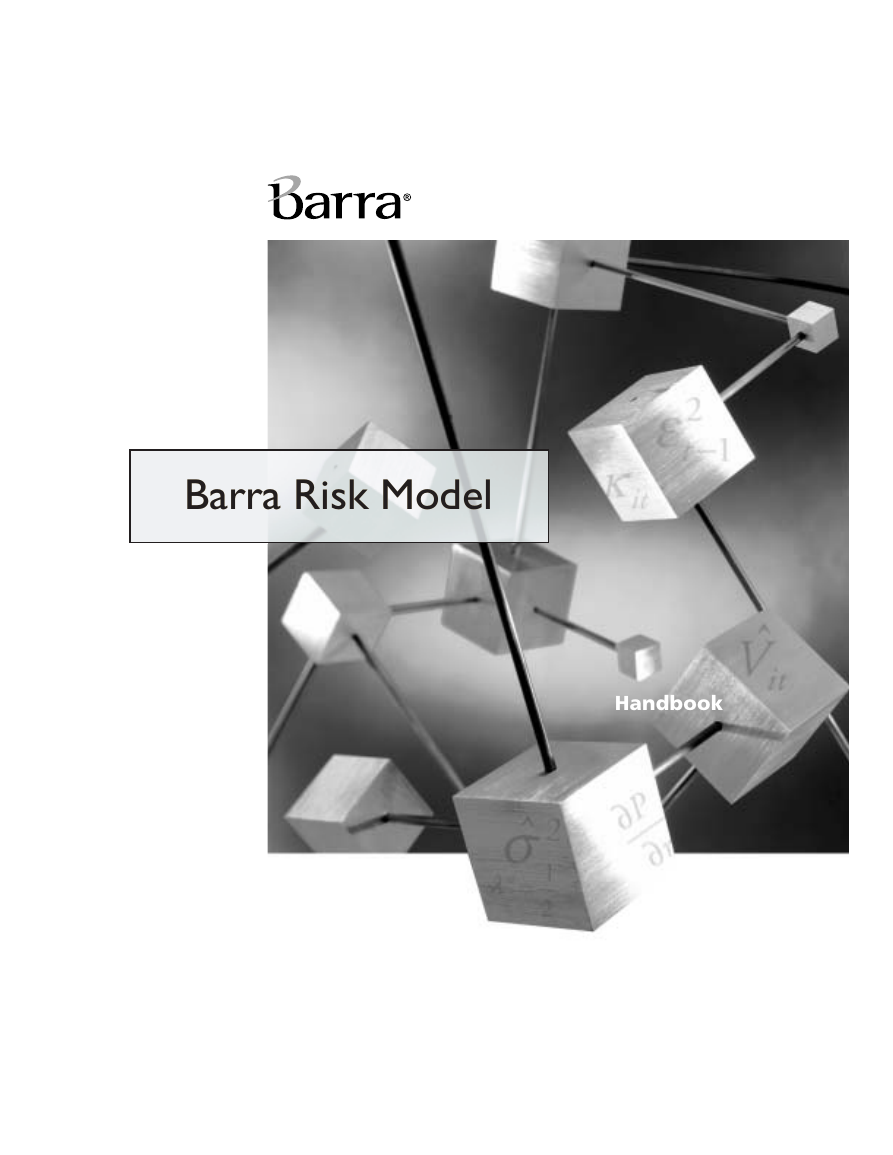
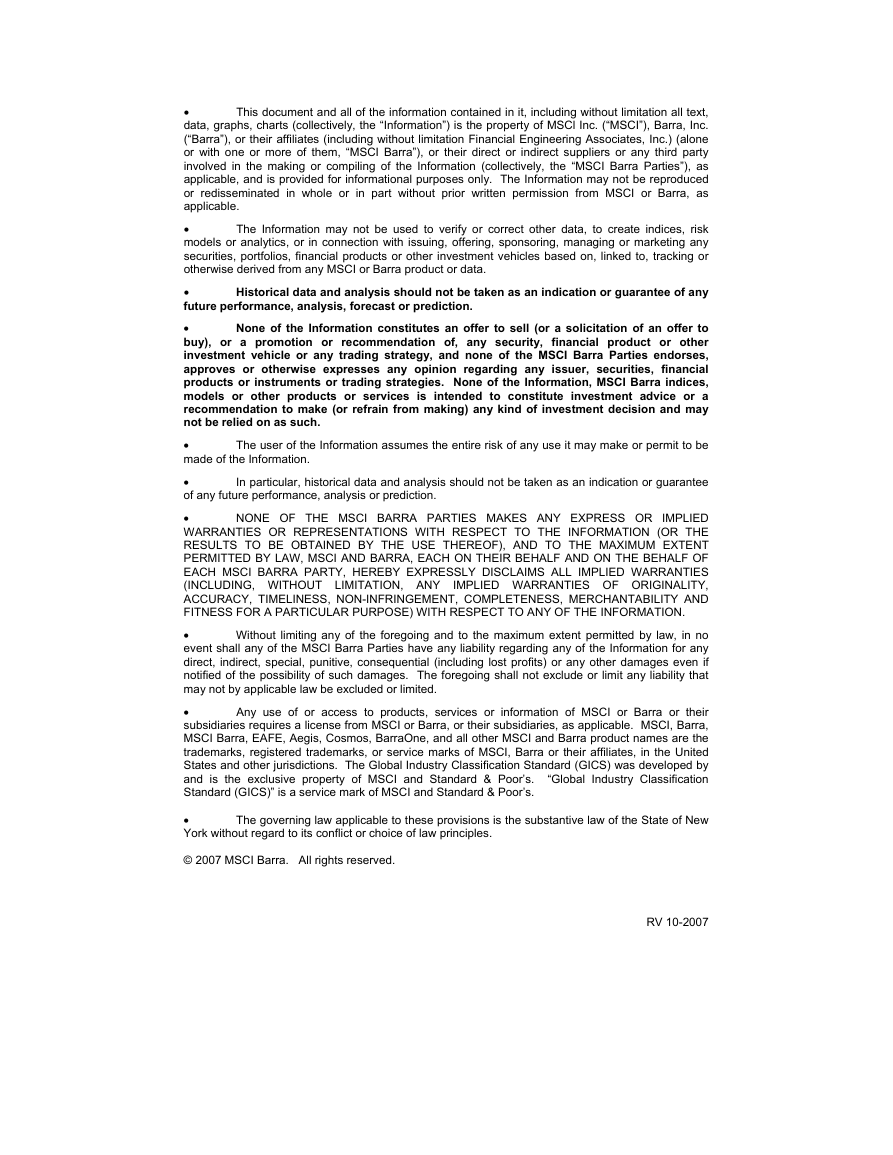
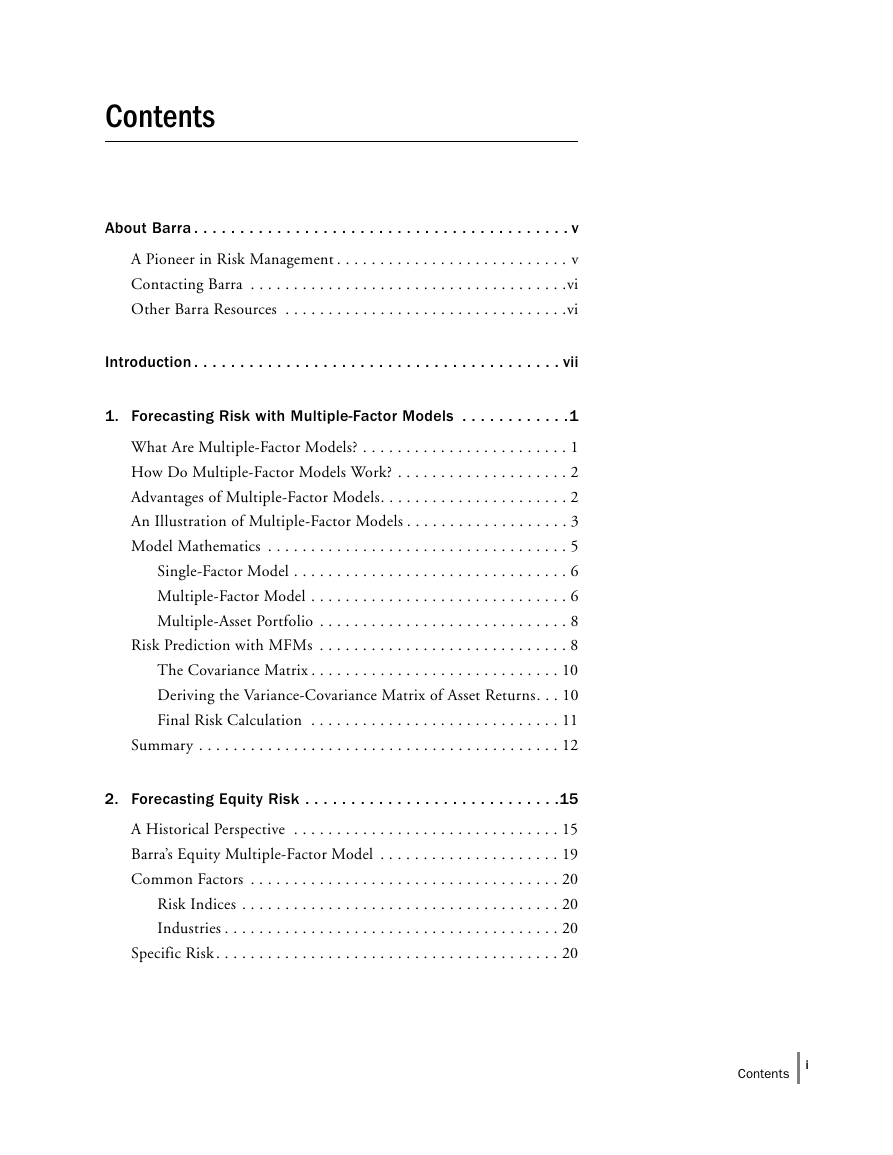
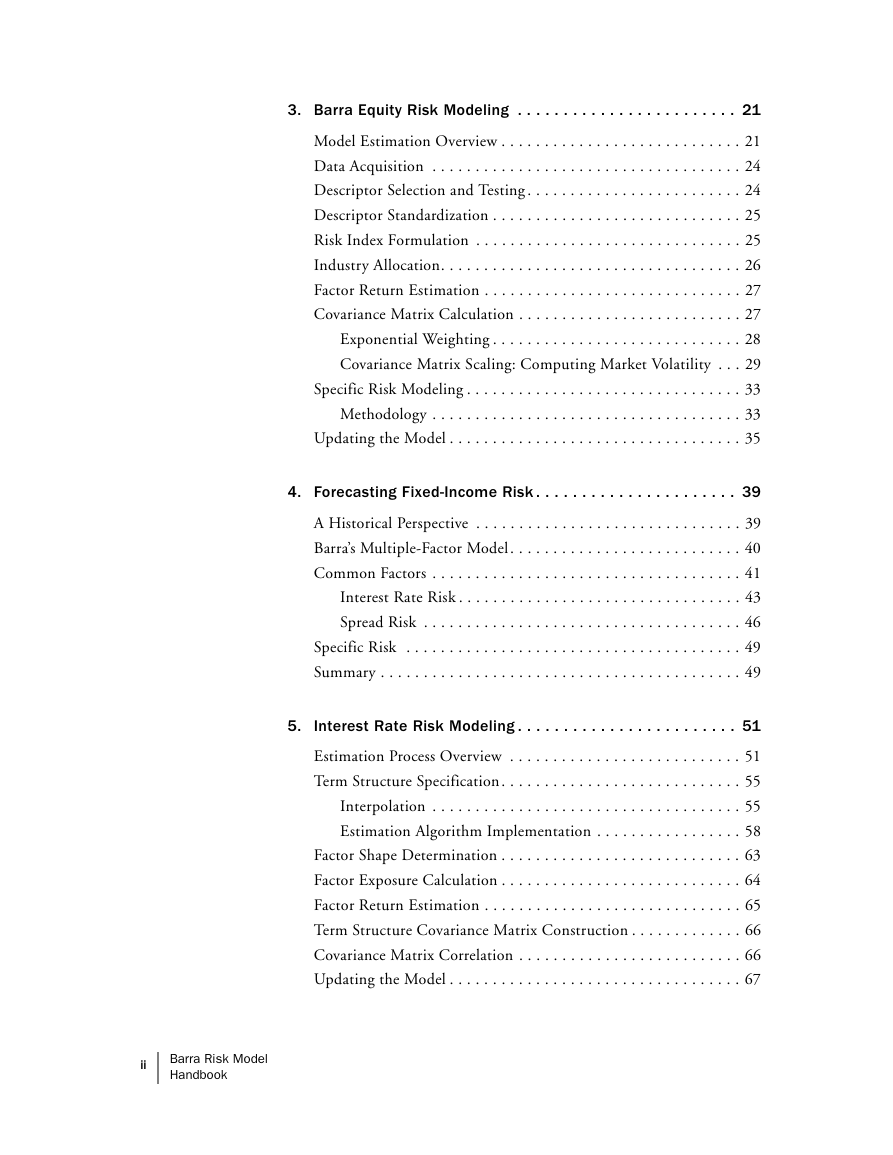
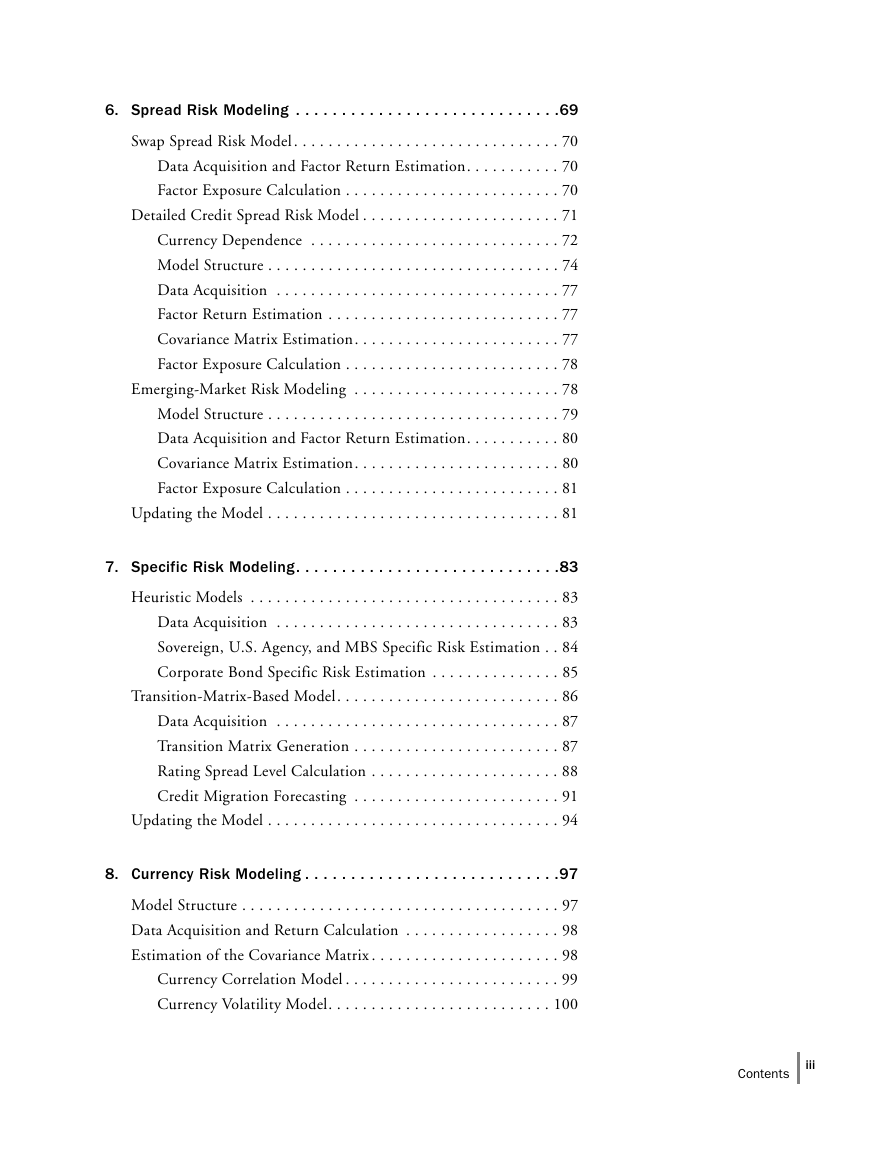
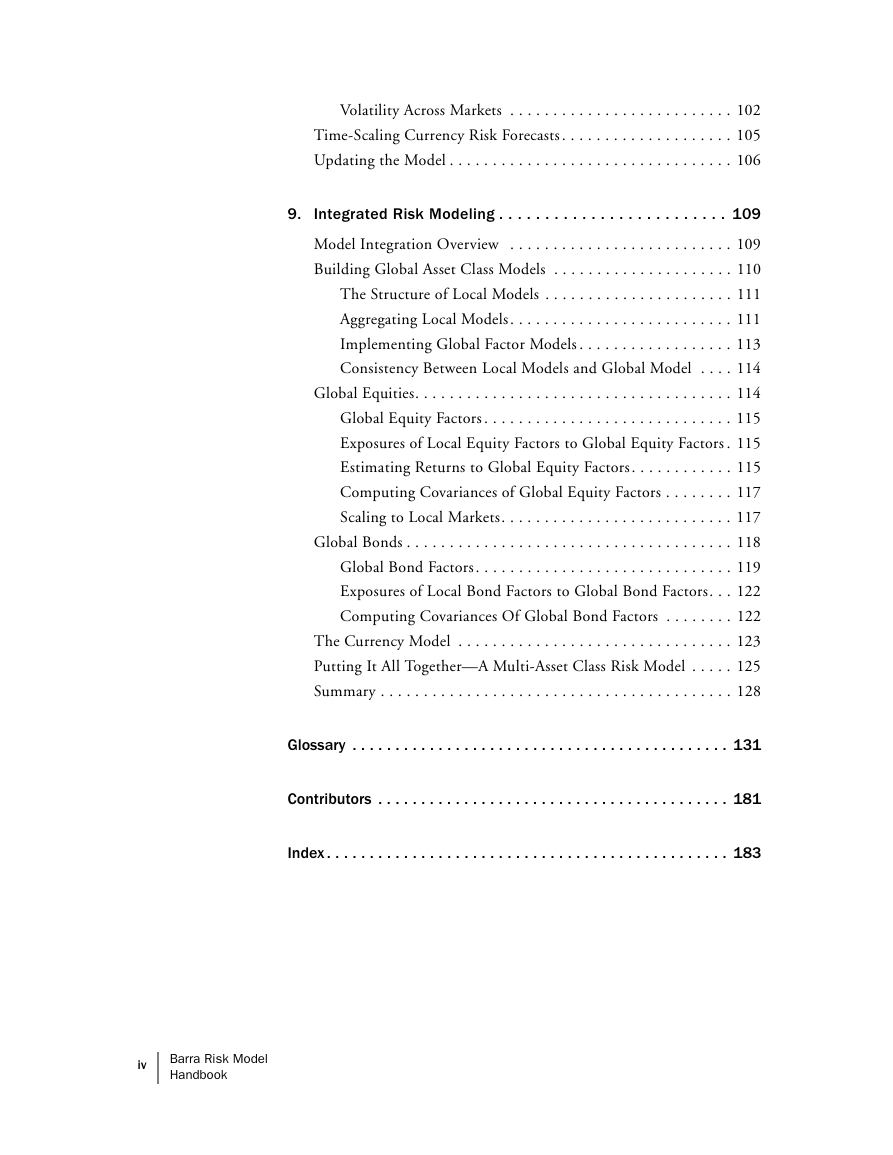
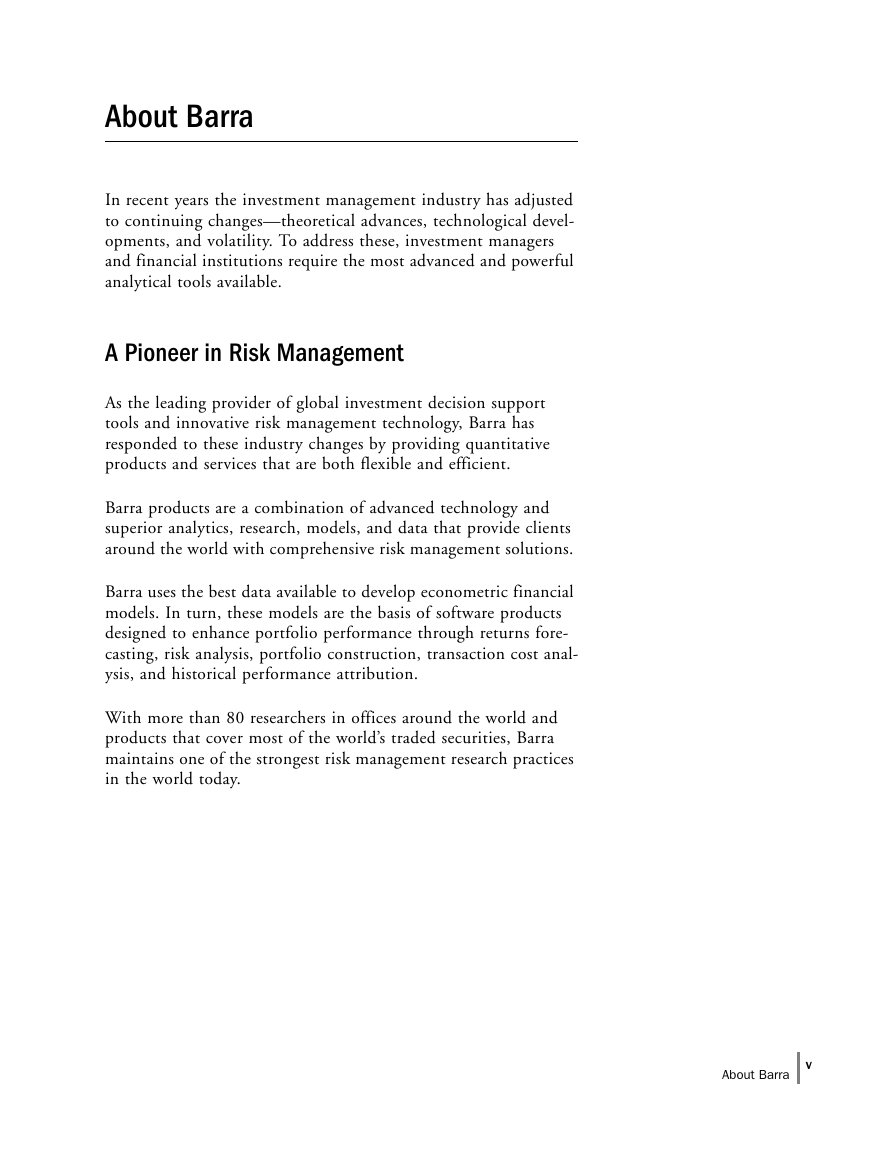
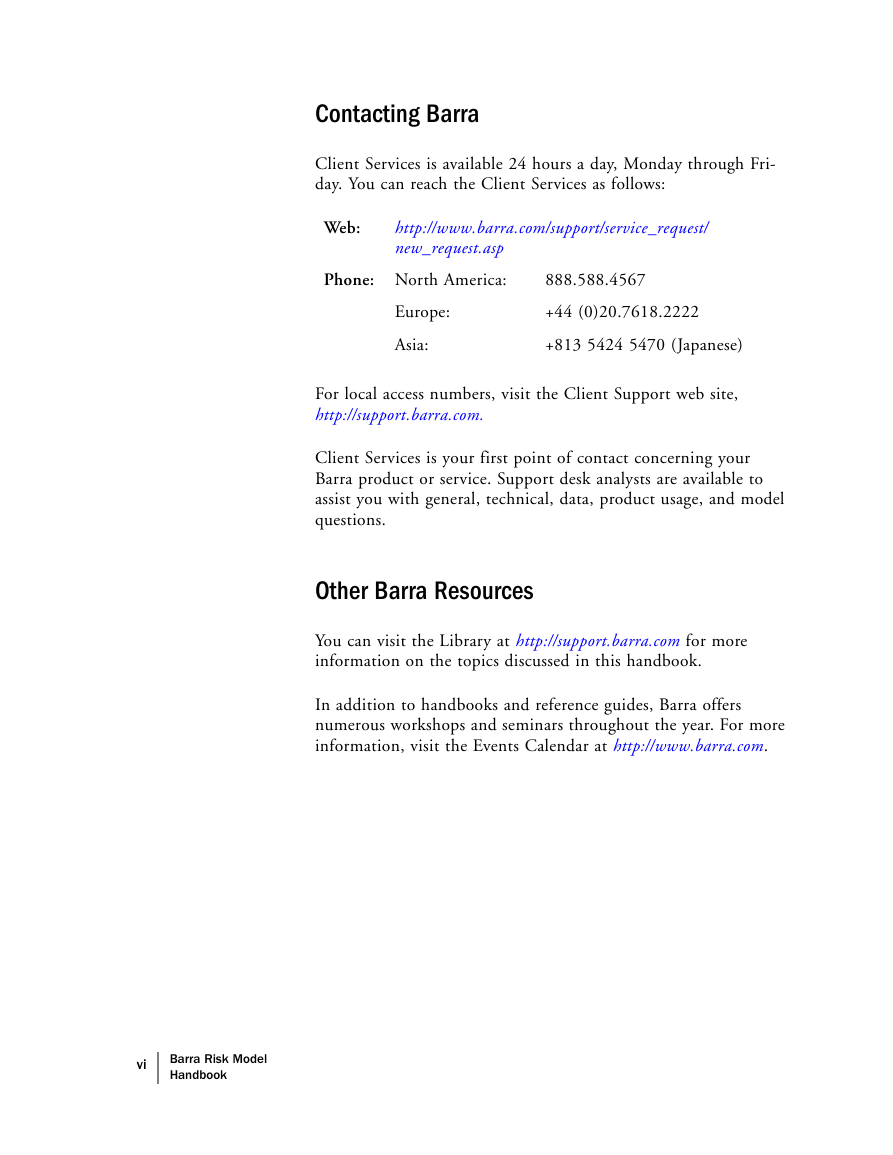








 2023年江西萍乡中考道德与法治真题及答案.doc
2023年江西萍乡中考道德与法治真题及答案.doc 2012年重庆南川中考生物真题及答案.doc
2012年重庆南川中考生物真题及答案.doc 2013年江西师范大学地理学综合及文艺理论基础考研真题.doc
2013年江西师范大学地理学综合及文艺理论基础考研真题.doc 2020年四川甘孜小升初语文真题及答案I卷.doc
2020年四川甘孜小升初语文真题及答案I卷.doc 2020年注册岩土工程师专业基础考试真题及答案.doc
2020年注册岩土工程师专业基础考试真题及答案.doc 2023-2024学年福建省厦门市九年级上学期数学月考试题及答案.doc
2023-2024学年福建省厦门市九年级上学期数学月考试题及答案.doc 2021-2022学年辽宁省沈阳市大东区九年级上学期语文期末试题及答案.doc
2021-2022学年辽宁省沈阳市大东区九年级上学期语文期末试题及答案.doc 2022-2023学年北京东城区初三第一学期物理期末试卷及答案.doc
2022-2023学年北京东城区初三第一学期物理期末试卷及答案.doc 2018上半年江西教师资格初中地理学科知识与教学能力真题及答案.doc
2018上半年江西教师资格初中地理学科知识与教学能力真题及答案.doc 2012年河北国家公务员申论考试真题及答案-省级.doc
2012年河北国家公务员申论考试真题及答案-省级.doc 2020-2021学年江苏省扬州市江都区邵樊片九年级上学期数学第一次质量检测试题及答案.doc
2020-2021学年江苏省扬州市江都区邵樊片九年级上学期数学第一次质量检测试题及答案.doc 2022下半年黑龙江教师资格证中学综合素质真题及答案.doc
2022下半年黑龙江教师资格证中学综合素质真题及答案.doc